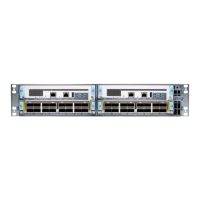In our example we dene a single default stac route to provide management network reachability to all possible
remote desnaons.
[edit]
root# set routing-options static route
0.0.0.0/0
next-hop
destination-IP
retain no-readvertise
13. Congure the IP address of a backup router. The backup router is only used while the roung protocol is not
running. The primary use of the backup router is to provide roung capability for the management port on the
backup Roung-Engine. This is because the backup Roung-Engine does not run the roung protocol daemon
(rpd).
14. In most cases the backup router is the same IP next hop as used for the management network's stac routes. We
again use a default route to provide the back up Roung-Engine with reachability for all possible remote
desnaons.
[edit]
root# set system backup-router
address
root# set system backup-router destination
0.0.0.0/0
15. Congure remote access for the root user over ssh. By default the root user is only able to log-in via the console
port. The root-login allow statement permits remote log-in for the root user.
[edit]
root# set system services ssh root-login allow
16. (Oponal) Display the conguraon to verify it's correct.
[edit]
root# show
system {
host-name
host-name
;
root-authentication {
authentication-method
(
encripted-password
|
public-key
);
}
services {
ssh {
root-login allow;
}
}
domain-name
domain-name
;
backup-router
address
destination
0.0.0.0/0
;
name-server {
address
;
}
10

